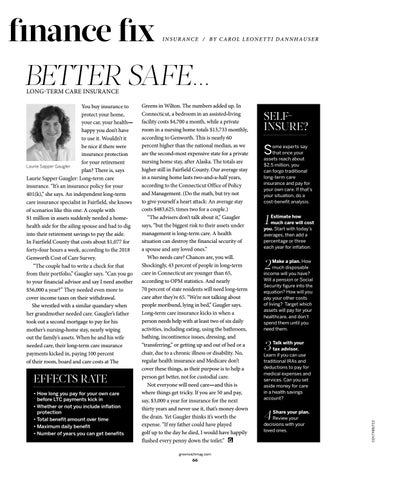fınance fıx
INSURANCE / BY CAROL LEONETTI DANNHAUSER
BETTER SAFE… LONG-TERM CARE INSURANCE
EFFECTS RATE • How long you pay for your own care before LTC payments kick in • Whether or not you include inflation protection • Total benefit amount over time • Maximum daily benefit • Number of years you can get benefits
Greens in Wilton. The numbers added up. In Connecticut, a bedroom in an assisted-living facility costs $4,700 a month, while a private room in a nursing home totals $13,733 monthly, according to Genworth. This is nearly 60 percent higher than the national median, as we are the second-most expensive state for a private nursing home stay, after Alaska. The totals are higher still in Fairfield County. Our average stay in a nursing home lasts two-and-a-half years, according to the Connecticut Office of Policy and Management. (Do the math, but try not to give yourself a heart attack: An average stay costs $483,625, times two for a couple.) “The advisers don’t talk about it,” Gaugler says, “but the biggest risk to their assets under management is long-term care. A health situation can destroy the financial security of a spouse and any loved ones.” Who needs care? Chances are, you will. Shockingly, 43 percent of people in long-term care in Connecticut are younger than 65, according to OPM statistics. And nearly 70 percent of state residents will need long-term care after they’re 65. “We’re not talking about people moribund, lying in bed,” Gaugler says. Long-term care insurance kicks in when a person needs help with at least two of six daily activities, including eating, using the bathroom, bathing, incontinence issues, dressing, and “transferring,” or getting up and out of bed or a chair, due to a chronic illness or disability. No, regular health insurance and Medicare don’t cover these things, as their purpose is to help a person get better, not for custodial care. Not everyone will need care—and this is where things get tricky. If you are 50 and pay, say, $3,000 a year for insurance for the next thirty years and never use it, that’s money down the drain. Yet Gaugler thinks it’s worth the expense. “If my father could have played golf up to the day he died, I would have happily flushed every penny down the toilet.” G greenwichmag.com
66
SELFINSURE?
S
ome experts say that once your assets reach about $2.5 million, you can forgo traditional long-term care insurance and pay for your own care. If that’s your situation, do a cost-benefit analysis.
1
Estimate how much care will cost you. Start with today’s averages, then add a percentage or three each year for inflation.
2
Make a plan. How much disposable income will you have? Will a pension or Social Security figure into the equation? How will you pay your other costs of living? Target which assets will pay for your healthcare, and don’t spend them until you need them.
3
Talk with your tax advisor. Learn if you can use traditional IRAs and deductions to pay for medical expenses and services. Can you set aside money for care in a health savings account?
4
Share your plan. Review your decisions with your loved ones.
CONTRIBUTED
You buy insurance to protect your home, your car, your health— happy you don’t have to use it. Wouldn’t it be nice if there were insurance protection for your retirement Laurie Sapper Gaugler plan? There is, says Laurie Sapper Gaugler: Long-term care insurance. “It’s an insurance policy for your 401(k),” she says. An independent long-term care insurance specialist in Fairfield, she knows of scenarios like this one: A couple with $1 million in assets suddenly needed a homehealth aide for the ailing spouse and had to dig into their retirement savings to pay the aide. In Fairfield County that costs about $1,077 for forty-four hours a week, according to the 2018 Genworth Cost of Care Survey. “The couple had to write a check for that from their portfolio,” Gaugler says. “Can you go to your financial advisor and say I need another $56,000 a year?” They needed even more to cover income taxes on their withdrawal. She wrestled with a similar quandary when her grandmother needed care. Gaugler’s father took out a second mortgage to pay for his mother’s nursing-home stay, nearly wiping out the family’s assets. When he and his wife needed care, their long-term care insurance payments kicked in, paying 100 percent of their room, board and care costs at The
